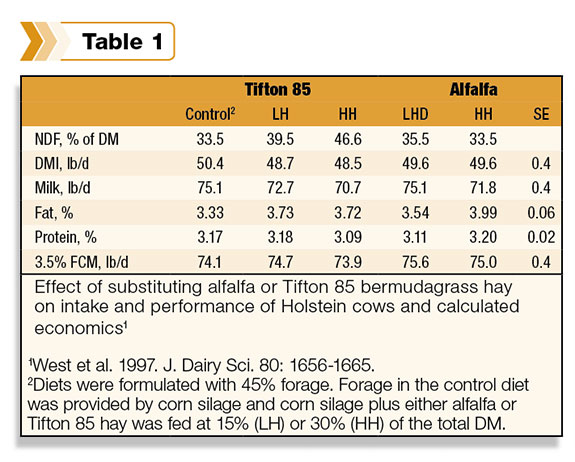During his career, Dr. Glen Burton developed and released many improved cultivars of bermudagrass for forage production.

The last cultivar released from his breeding program was Tifton 85 bermudagrass (Tifton 85), which has higher dry matter (DM) yields and in vitro DM digestibility (IVDMD) than other bermudagrass cultivars typically grown in this region (Table 1).
In Tifton 85, the higher IVDMD digestibility is a result of increased NDF digestibility because of lower concentrations of lignin and ether ferulic acid, a form of lignin.
These characteristics of Tifton 85 result in greater digestible energy concentrations compared with other bermudagrass cultivars.
When formulating diets for lactating dairy cows, nutritionists typically limit the amount of bermudagrass incorporated into the diet because of its high NDF concentration. This is based on the recommendation that maximum fat-corrected milk (FCM) yield is achieved when NDF intake is 1.2 ± 0.1 percent of bodyweight.
However, this value does not take into account NDF digestibility, which also influences intake. Michigan State researchers reported increased DMI and milk yield as forage NDF digestibility increased, which is a result of improved passage rates and reduced rumen fill.
In early research conducted at University of Georgia (UGA), dairy cows in early lactation were fed diets with increasing amounts of forage provided from either alfalfa or Tifton 85 bermudagrass hay to early lactation cows without adjusting diets for NDF content.
Forage provided 45 percent of the dietary DM and was provided by corn silage (CONT) or a combination of corn silage plus 15 or 30 percent of either alfalfa or Tifton 85 hay.
As expected, dietary NDF concentrations increased as the amount of hay in the diet increased, especially for those diets containing Tifton 85 bermudagrass (Table 1). Dry matter intake was lower for cows fed the diets containing Tifton 85 than those fed either the control diet or the diets containing alfalfa hay.
Milk yield was also lowest for cows which were fed the diets containing Tifton 85, especially for the diet containing 30 percent Tifton 85, compared with control or those supplemented with alfalfa hay.
Milk fat percentage increased when cows were fed diets containing Tifton 85 hay resulting in similar yields of 3.5 percent FCM. These results demonstrate the need for accounting for the higher NDF content of diets based on Tifton 85 bermudagrass.
As illustrated above, the higher NDF content of Tifton 85 can limit DMI if diets are not balanced to avoid rumen fill.

We conducted another trial in which diets balanced to provide similar NDF concentrations and based on corn silage plus 12.2 percent of either alfalfa hay or Tifton 85 bermudagrass haylage were fed to mid-lactation Holstein cows.
There were no differences in DMI observed between the diets (Table 2).
Although the diets were balanced to have similar NDF concentrations, cows fed the diets supplemented with Tifton 85 consumed more NDF as a percent of bodyweight.
These results suggest that the NDF in Tifton 85 was digested at a rate and extent which did not limit gastrointestinal fill when fed at this level.
Milk yield and composition were similar for cows fed diets supplemented with either alfalfa hay or Tifton 85 haylage.
More recently, we conducted a trial to evaluate the potential effect of feeding combinations of forages that have greater-than-normal NDF digestibility to cows in early lactation during the fall.
Diets were formulated using either normal or brown midrib (BMR) corn silage, with or without Tifton 85 hay. All diets contained ryegrass silage as well.
Dietary NDF was slightly higher for the diets supplemented with Tifton 85 (35.7 vs. 39.2 percent NDF).
No differences were observed in DMI or milk yield with the addition of Tifton 85, but milk fat percentage was higher for diets containing Tifton 85.
Diets containing BMR corn silage supported slightly higher DMI, but this did not translate into higher milk yield in this trial. The forages used for this trial were all high-quality (> 50 percent NDF digestibility in 30 hours) and did not limit intake.
Compared with other cultivars of bermudagrass, Tifton 85 bermudagrass produces higher yields of forage that contains more NDF, but the NDF is more digestible.
Diets for lactating dairy cows should be balanced for the higher NDF content of Tifton 85 to avoid rumen fill, which can limit DMI and milk yield.
When we examine all of our research to date, NDF concentrations more than 40 percent of the dietary DM appear to limit intake. When diets are balanced for NDF concentrations, intake and performance can be similar for diets supplemented with either Tifton 85 or alfalfa. FG
References omitted due to space but are available upon request. Click here to email an editor.












